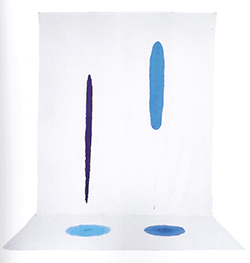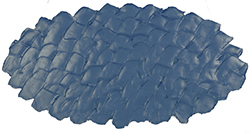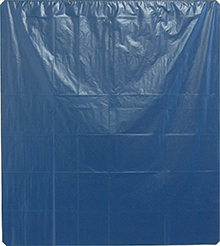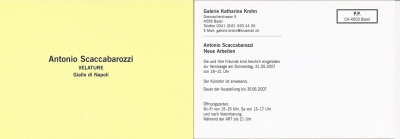The Weight of a Picture
How much does a picture weigh? At first the question seems absurd, especially if one takes it literally. For what does the material weight of a picture have to do with its artistic content? It is precisely this measuring and weighing of a picture, however, which has again and again attracted the attention of Antonio Scaccabarozzi over the course of his nearly forty-year investigation of painting. And his rigorously logical answers are formulated, for example, as 0.125 g. or 100 mg or 40 cubic centimeters. Since 1980 within the framework of his Misurazioni (Measurements), for instance, there have arisen works in which a specific amount of thinned paint is sprayed directly onto the canvas and, in spite of each time being exactly the same quantity, spreads outward into variously sized spots. 0.125 g. of blue chalk is distributed in slanted hatching upon the cardboard in such a manner that there is a fading progression from left to right. In the gestural, starkly diagonal process of painting which characterizes the series Quantità (Amount, from 1983), thin and transparent polyethylene foils are painted with the specific amount of monochrome paint which the foil is capable of absorbing. And the Essenziali (Essentials, from 1990) are unsupported paintings in which the paint both signifies and supports itself as a mixture of acrylic and glue.
So how much does a picture weight? On the one hand, precisely as much as it contains on the material level. And on the other hand, as the sum of all those qualities which cannot be accurately weighed, measured, and analytically determined. Scaccabarozzi has always worked with the aspect of a dialectical, paradoxical tension within the picture, and it is precisely this tension that imbues his oeuvre with a freshness, lightness and presentness which is certainly justified in claiming an exceptional position in the area of color painting, within the domain of essential definitions of color and image. The quintessence aimed at by all works of this artist is the clarification of a fundamental differentiation. It is a matter of the difference between that which is physically present as what has, since the artist's beginning, been a minimal and over the years even further-reduced material prerequisite for his work. and that which can thereby be created in terms of artistic complexity and visual experience. This divergence could be expressed in terms of the distance between external weight and measurements on the one hand, and internal substance on the other. Within the long tradition in which painting has worked towards allowing color to come into its own, towards distilling out of the ongoing reduction of painterly means that essence of a pictorial experience which both stands for itself and creates out of itself, Scaccabarozzi's oeuvre makes a deep impression through the utter absence of any pathos-drenched solemnity. That which is offered to view is in the best sense elementary without. however, slipping into the fog of ceremonious sublimity; it is methodically exact without becoming caught in the snares of formalistic self-satisfaction. It exudes a twinkling-eyed, philosophical wittiness which, with benign smile but insistent grip, escorts right off the premises both the raised index finger and the claim to absolute validity.
Already in 1979 Scaccabarozzi demonstrated with Misura reale-misura rappresentata (Real Measure-Represented Measure) what perfect sparks of artistic intelligence can be struck out of these components. A black-and-white photograph depicts a sparse stretch of forest and, in the background, houses whose outlines can be only dimly recognized. Between two tree trunks framing the sides of the picture is a white bar indicating, with 516 cm, the distance between the two trunks. In the middle of the lower, white-colored third of the picture is a segment of measuring tape whose 41 cm correspond exactly to the length of the bar which is visible in the photo. Everything in this work plays with the idea of a mathematical exactness and absoluteness, only to conduct these striven-for qualities ultimately into an ironical, philosophical paradox.
There exists no path leading from the real distance between the trees to the distance asserted by the picture. Not only do Scaccabarozzi's measurement of the world and the dimensioning of this measurement in the picture indicate the categorical differences between reality, the picture of this reality, and the representation-free space of the autonomous picture. They also make it strikingly clear that each and every picture can be measured and evaluated only in terms of itself and according to its utterly individual criteria, while at the same time it remains connected in a contradictory manner to the very world from which it so energetically endeavors to free itself. Moreover, the work emphasizes its own inherently double nature by marking as a pictorial field the zone between the bar that indicates the distance between the trees and the measuring tape, and thereby designating it as a picture within the picture. Just as in a picture puzzle, we see in Misura reale-misura rappresentata the picture as a picture of the picture, only capable of asserting its reality by permanently oscillating between its own immeasurability and outer, representative measurement.
Something of this mental and motile energy may be found in all of Scaccabarozzi's works: an insatiable hunger to oppose any evenly worked-out relationship between objects and images, to refuse them a self-satisfied, harmonious solution. In the series of the Ouantità- and Essenziali-works, the diagonal movement of the broad brush and the palette-knife leads to jagged, saw-toothed borders of paint and picture, so that the acrylic-and-glue skins of the Essenziali-series, as well as the monochromatic color fields painted upon transparent polyethylene in the Ouantità-series, are imbued with a ceaseless, subliminally aggressive vibrato. Inasmuch as these works themselves repudiate their geometrical, rectangular, decorously respectable closed status. they fill both themselves and their surroundings with an exemplary disquiet. The saw-tooth of their edges gnaws at their inner constitution just as it extends onto the wall and into nearby space where, grating and sharp-edged, it roughens the surroundings and reveals itself to be angular and resisting.
So that no misunderstandings arise here, let it be emphasized that this movement never goes so far that, in an act of destruction or self-aggression, these artworks categorically attack
2 Iniezione endotela cmc 40, 1980
themselves or their surroundings, but that instead it is a matter here of an experimental arrangement which not only respects the aesthetic imperative of a fundamental balance between centripetal and centrifugal forces, but also views this equilibrium as its point of departure and goal of attainment. This is particularly true for the works of the last two years, in which Scaccabarozzi returns to a more classical, painterly trial configuration. Here the point of departure is a canvas covered with one respective color which then is successively painted over by up to sixteen monochromatic, vertical layers of different-colored paint. The original color influences all subsequent applications just as they themselves alter the fundamental color field, for example by almost completely covering or particularly emphasizing it. In every case, the artist always seeks out that point at which the beginning and end of the picture are brought into precise balance.
In this regard it is and remains noteworthy to how little an extent Scaccabarozzi, during his investigations of the pure experience of color, has allowed himself to be guided or even influenced by the predominant mainstream tendency towards a markedly emotional, coloristic idyll. There always remains the question as to how it is possible to connect color, as an experience which has attained its inherent nature, with the contradictory character of reality, without thereby causing color to take on illustrative or mimetic aspects. It is always a matter of zones of friction in which one's own measurement encounters a foreign measurement and thereby heats up in a productive flare.
The painterly skins, those limp, rubber-like pieces which can be implemented everywhere-and which inform the selected background just as they are informed by it-represent one of the possibilities for generating this sort of frictional heat. The polyethylene foils with which Scaccabarozzi has been working ever since the early nineteen-eighties are another possibility. In the Quantità-works, this "poor," industrial, wear-and-tear material not only serves as carrier for the thinly applied paint, but itself establishes the connection between picture and wall. Through its electrostatic charge, the foil sticks to the wall like a skin and nestles against it just as the paint, for its own part, presses snugIy against the polyethylene surface. With
Essenziale blu 1990 cm 41x80
no additional means of attachment, these works remain autonomous within themselves and hence subject to the laws of reality: changes in temperature as well as the force of gravity assure that, with time, the foils develop wrinkles or broad undulations and thereby, without altering their aggregate state-similarly to the case of Misura reale-misura rappresentata-offer testimony to the non-cancelable, contradictory connection between self-expression and literal imprisonment within the world.
With the works created since 1996/97, Scaccabarozzi radicalizes his position once again. Utilized here as well are the familiar polyethylene foils, this time without an additional application of paint but instead cut into elementary geometrical forms and attached to the wall along their respective upper edges, so that the extremely thin, transparent, wanly colored or black foils can be moved by each breath of wind. What unfolds here is a round dance of ephemerality. The delicate foils function as a membrane for the light which is refracted in their bends and folds, is caught in their diaphanous surfaces and imbues the dull turquoise and pale blue, gray and broken olive-green colors with a luminosity in which the humble artistic material attains an astoundingly self-evident naturalness. The orthogonal incisions through the plastic skin transform the foil into a presence hovering between picture, sculpture and object. Vaguely recalling architectural plans to some extent and repeatedly touching upon the theme of the pictorial segment and the picture frame, these works focus in a careful and precise manner upon the paradoxical links between sign, signification and self-signification.
With a large, space-encompassing work created in 1998, Scaccabarozzi has given valid formulation to this confusing and productive interconnection. The work consists of a transparent plastic strip which is cut like a grid measuring five meters in length and one in height, and which seals off the space unfolding behind it so as to deny entry to it. As a permeable membrane, the foil activates the space and simultaneously transforms it into an image of itself, inasmuch as it positions itself as a barrier between that space and the viewer. The foil in turn metamorphoses the almost-nothingness of its material substance into a space-encompassing, installational-sculptural proposition which at the same time insists upon its ephemeral nature. The incised structure of the foil makes it possible to choose to read the work as either representational or self-referential: as a grid, as a fence, as a serial succession of elementary, rectangular forms, or as a sequence of empty, framed pictorial squares. As such, in that they thematize the fundamental prerequisite for the very existence of a picture-namely its delimitation, its frame-and thereby describe the picture itself as a gap, these empty squares make it clear, in a basic and veritable manner, that a picture can only acquire the characteristic of giving expression to its own nature by being transformed into a shadow of itself.
Banchisa 14, 2003 cm 111x99
STEPHAN BERG
translated by George F Takis

